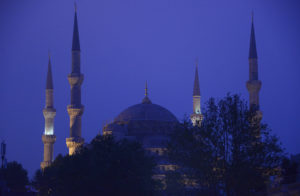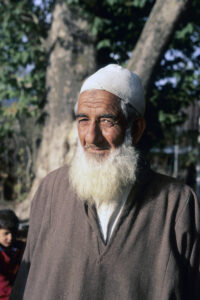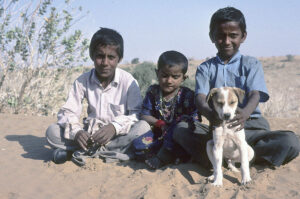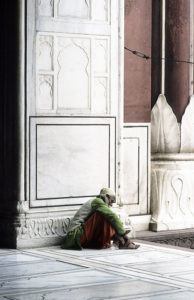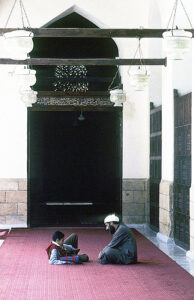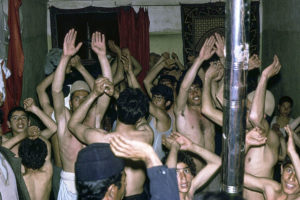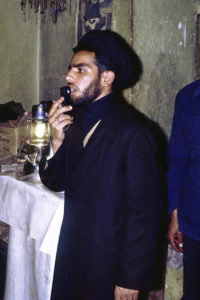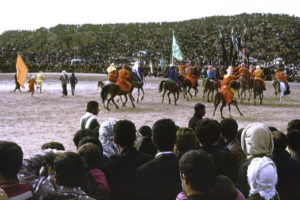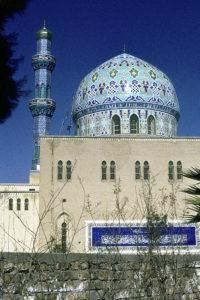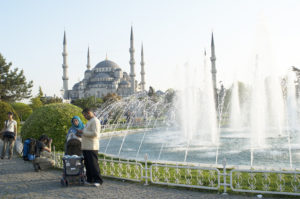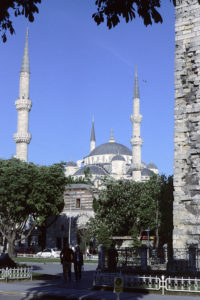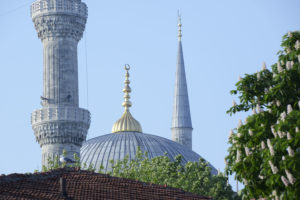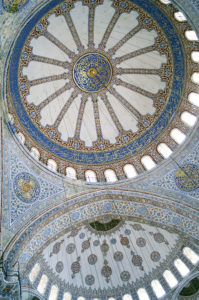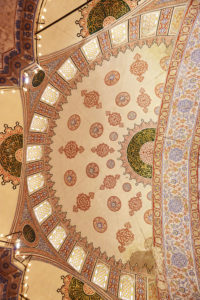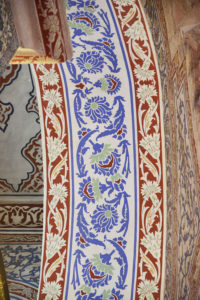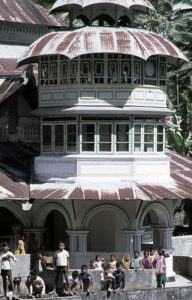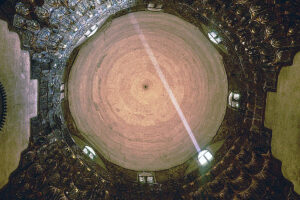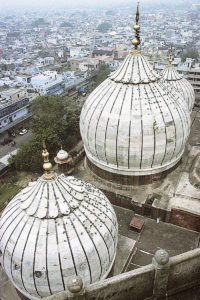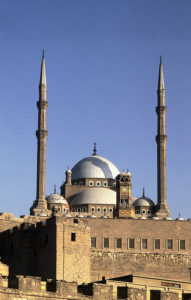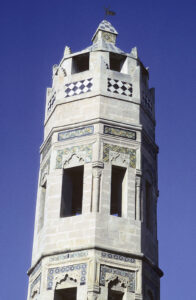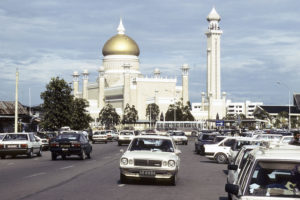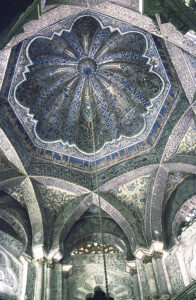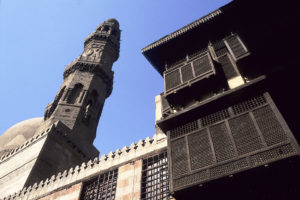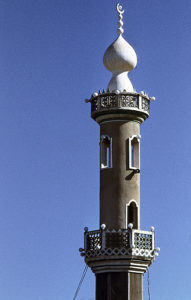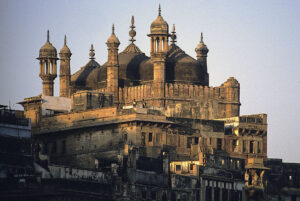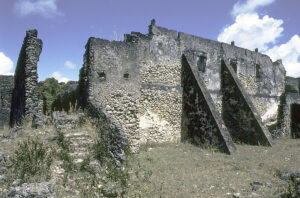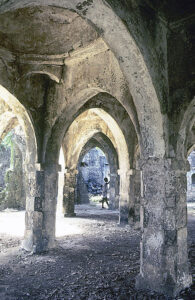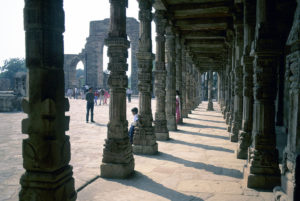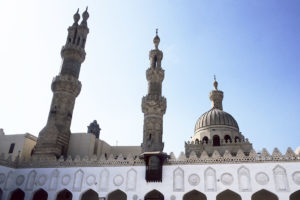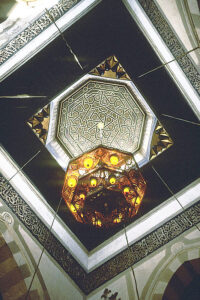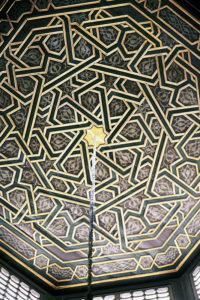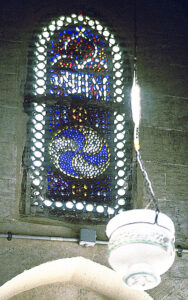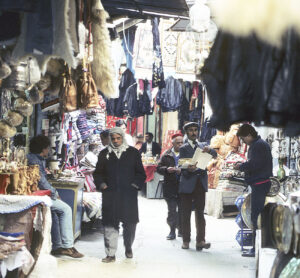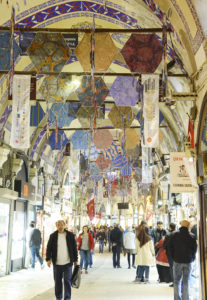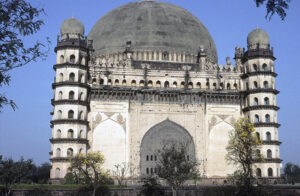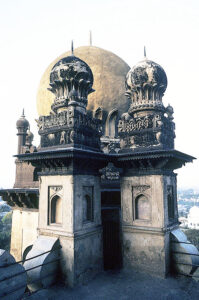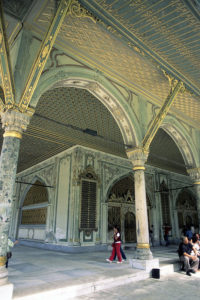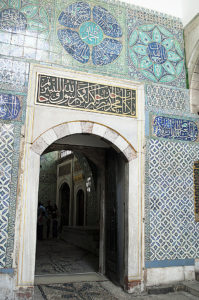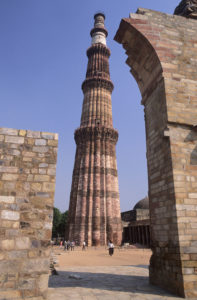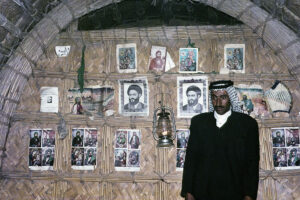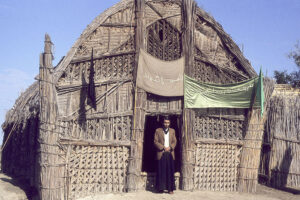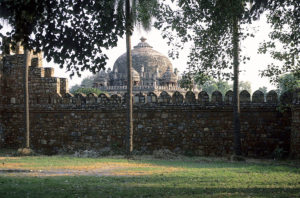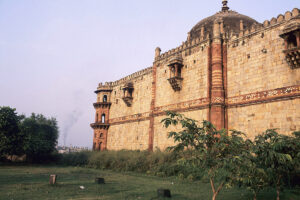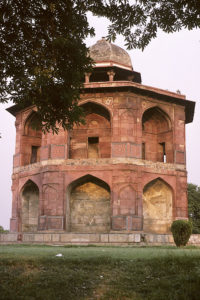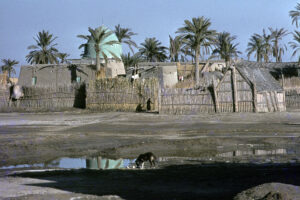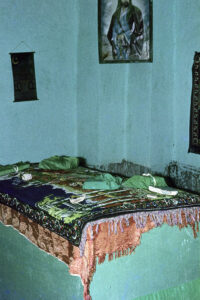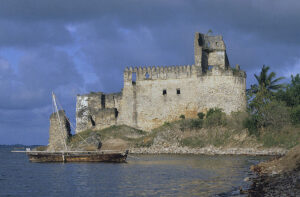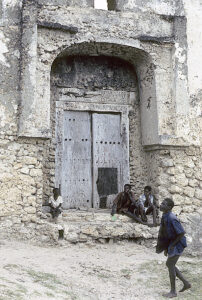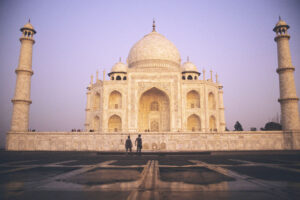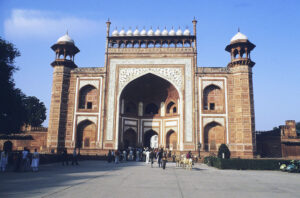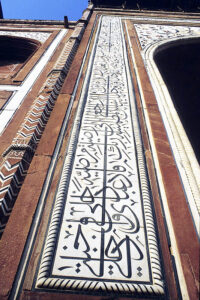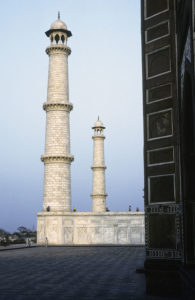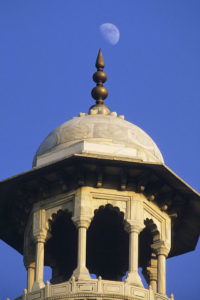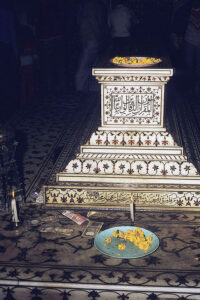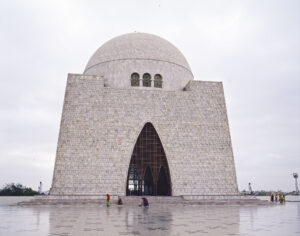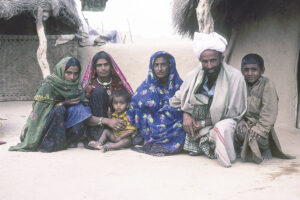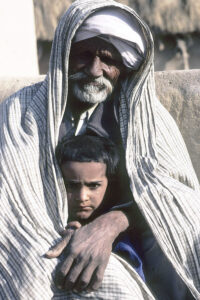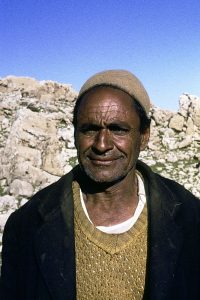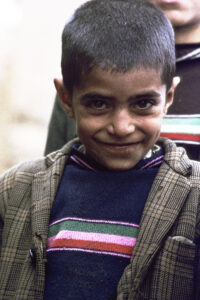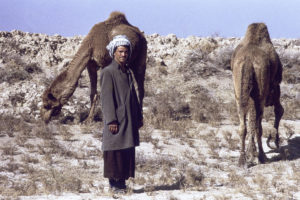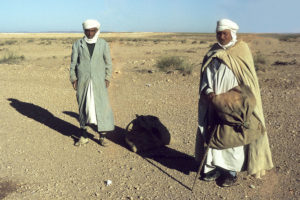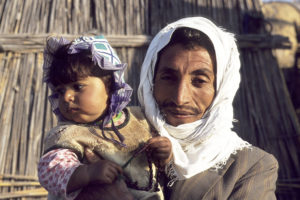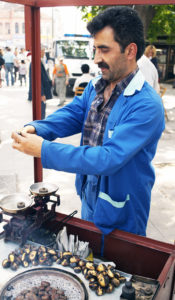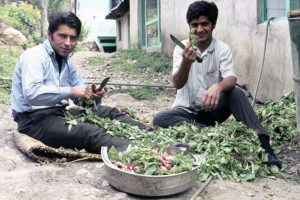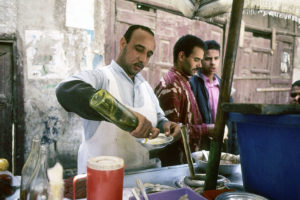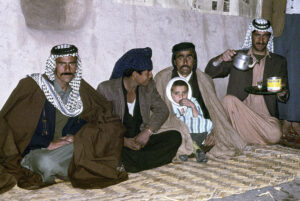Islam
Dawn at the Sultan Ahmed Camii (‘Sultan Ahmed Mosque’), Istanbul, Turkey. (Photo copyright © by Kaj Halberg)
Bearded Muslim, Pahalgam, Kashmir, India. (Photo copyright © by Kaj Halberg)
These paintings, depicting the Ka’aba in Mecca, a mosque, and flowers, adorn a wall, surrounding a garden in Luxor, Egypt. (Photo copyright © by Kaj Halberg)
Muslim children, Thar Desert, Rajasthan, India. (Photo copyright © by Kaj Halberg)
The founder of Islam, Muhammad ibn Abdallah, who lived c. 570-632 A.D., is often referred to as a prophet, or apostle, of Allah (‘God’), but in reality Abdallah means ‘God’s servant’.
In 610, he began receiving what Muslims regard as divine revelations, delivered through the angel Gabriel. His preachings soon spread among the common people, but were met with hostility by the leaders of Mecca, who worshipped a number of gods, and whose center of worship was a square building, called the Ka’aba, which contained a sacred black meteorite.
However, Muhammad was protected by an influential uncle, Abu Talib, but upon his uncle’s death around 619, Muhammad migrated to the city of Yathrib (later known as Medina), where he soon got thousands of followers. His new faith was called Islam (‘submission to the will of God’), and its followers were called Muslims (‘submitters of God’).
A majority of Muslims, however, claim that Islam did not start with Muhammad, but was the original faith of a number of persons, whom they regard as prophets, including Adam, Noah, Abraham, Moses, David, and Jesus, and that the final prophet was Muhammad.
Today, Islam is the second-largest religion in the world (after Christianity), with about 1.8 billion followers worldwide.
This Islamic mullah (priest) in the city of Karakol, Kyrgyzstan, is explaining principles of Islam. (Photo copyright © by Kaj Halberg)
Five Pillars of Islam
The Five Pillars of Islam are five rules, which every Muslim must obey in order to live his life according to Islam. These pillars are Shahadah, Salat, Zakat, Sawm, and Hajj.
Shahadah. With a sincere heart, every devout Muslim must recite: “There is no god but God, and Muhammad is his messenger.”
Salat. Five times a day, the muezzins perform the adhan (from adhina, meaning ‘to listen’, or ‘to be informed about’), from high slender towers, called minarets. The adhan is the Islamic call for ritual prayer: “Allah-u-akbar! As-hadu-an-la-ilaha-il-Allah! Muhammadun-rasul-Allah!” (“God is great! I announce: There is no god but God! Muhammad is God’s servant!”). Originally, the muezzins were shouting the message between cupped hands, but today the announcement is given through loudspeakers.
The first prayer, al fajr, must take place at the crack of dawn, when there is enough light to distinguish a black thread from a white one. The other four prescribed prayers take place at noon, in the afternoon, when the sun is at an angle of 45 degrees with the horizon, at sunset, and two hours after sunset.
These prayer times originated in Arabia. As Muslims have moved to far northern and far southern latitudes, they are, naturally, not able to observe these times. Instead, they have appointed fixed hours of the day for praying.
Prayer can take place anywhere, but on Fridays, the weekly Muslim holiday, preferably in a mosque. Before you pray, you should wash your face, hands and feet, and during the prayer, your face must point in the direction of the Ka’aba in Mecca. Prayers are performed partly standing, partly kneeling, and partly lying down, with your forehead touching a small prayer rug.
Zakat. You must give alms to the poor.
Sawm. During the month of Ramadan, you must fast between dawn and dusk. Naturally, this cannot be observed by Muslims who live at far northern or far southern latitudes. Instead, they have appointed fixed hours of the day for fasting.
Hajj. At least once in your lifetime, you should undertake a pilgrimage to the sacred Ka’aba in Mecca. When Muhammad and his followers took Mecca in 630, they destroyed the pagan idols, which surrounded the black meteorite, but Muhammad embraced the stone itself as the sacred gift of God to Adam.
During the Hajj, the most important ceremony is to circumambulate the Ka’aba seven times, each time kissing the black stone. A person, who has made this pilgrimage, is honoured by the title of Hajji.
This man is studying sacred scripts inside the Jama Masjid (‘Friday Mosque’), Old Delhi, India. (Photo copyright © by Kaj Halberg)
Mullahs (Muslim priests) may be consulted, in case you want to discuss a problem. This picture shows a boy and a mullah in conversation inside the Al-Azhar University, Old Cairo, Egypt. (Photo copyright © by Kaj Halberg)
Praying Muslims in the Jama Masjid (‘Friday Mosque’), Vijayapura (formerly Bijapur), Karnataka, India. (Photo copyright © by Kaj Halberg)
Sunni and Shi’a
The origin of the two major denominations within Islam, Sunni and Shi’a, almost date back to the foundation of Islam. Following the death of Muhammad in 632, certain Muslims, who later called themselves Shi’a, from Shi’atu Ali (‘followers of Ali’), only acknowledged direct descendants of the Prophet as his heirs, maintaining that God, via Muhammad, had selected his cousin, Ali ibn Abi Talib (601-661), who was also his son-in-law, as imam – leader of Islam. Ali’s sons, Hassan and Husain, were imam number two and three, succeeded by their descendants.
In 681, Husain and his followers travelled to Iraq to fight against the Caliph of Damascus, who claimed that he was the true heir of Muhammad, selected by a council of elders. The Shi’a did not acknowledge this choice, maintaining that only God could appoint Muhammed’s heirs. In a battle at Karbala, Husain and his men were all killed, and from this day, the Caliphs of Damascus, and later Baghdad, held the power within Islam.
The Shi’a fervently commemorate the death of Husain. In his book Reisebeschreibung nach Arabien und andern umliegenden Ländern (Gloyer und Oldshausen, Hamburg, 1837, in English Travels Through Arabia and Other Countries in the East, Performed by M. Niebuhr, Gale Ecco, 2018), German cartographer and mathematician Carsten Niebuhr gives a vivid description of a group of pilgrims, paying a visit to the tomb of the martyr in Karbala, in present-day Iraq: “I was genuinely puzzled by watching the devotion, with which the superstitious people already in the front yard kissed the entrance door, and also later kissed the door of the mosque. Inside the temple, they eagerly kiss the floor, and I was told with conviction that to some devotees the death of Hössein is so sad that they hit their head agains the wall and the iron grids. It has been told that some devotees have become so mad with rage that they have killed themselves at their great imam’s grave, believing that they will also be recognized as martyrs, and go to heaven, because they have given their life for the sake of Hössein. I must confess that I have never heard anything more plaintive than these devoted Shi’a. People screamed and howled as if Hössein had been their father and had been murdered this day; this was by no means false, like the professional mourners who weep over a deceased for money, but so genuine that the eyes of those who left the mosque were swollen from crying.”
The Shi’a acknowledge a succession of 12 imams, and they maintain that the last of them, Muhammad ibn Hasan al-Mahdi (868-941), vanished without a trace, but will return in due time as the ultimate saviour of mankind and, together with Isa (Jesus), bring peace and justice to the world.
In 818, the 8th imam, Ali ibn Musa al-Riḍha, in Iran known as Imam Reza, was murdered by order of the Abbasid Caliph, al-Ma’mun. The place he was buried was called Mashhad al-Ridha (‘Martyrdom of al-Riḍha’), and in the late 9th Century, a dome was erected on the grave. Later, numerous other buildings were built on this place, which constitutes the world’s largest Islamic temple complex.
Mashhad, eastern Iran, is a sacred city to the Shi’a Muslims, centered around the mausoleum of Imam Reza. This picture shows tiles, displaying beautiful calligraphy, on the outer wall, surrounding the mausoleum. (Photo copyright © by Kaj Halberg)
Muharram is an annual Shi’a feast, which commemorates the death of Husain, Muhammad’s grandson, in the battle of Karbala 681. The following three pictures were taken during Muharram, in Luristan, south-western Iran.
During Muharram, men and boys bare their chest and beat themselves rhythmically, moaning and groaning. Meanwhile, a priest is chanting into a microphone. The air inside the room soon became pungent with sweat and heat. (Photos copyright © by Kaj Halberg)
During Muharram, in the town of Shush, horse men perform as Husain’s warriors during the battle of Karbala, 681, in which Husain and his followers were all killed. (Photo copyright © by Kaj Halberg)
Sufism
Sufism is a mystic order within Islam, which began very early, representing “the main manifestation and the most important and central crystallization of mystical practice in Islam.” (Source: Chittick, W.C. (ed.). The Essential Seyyed Hossein Nasr. World Wisdom, Bloomington, Indiana)
Throughout history, Sufis have often belonged to various ṭuruq (‘orders’), centered around a wali (‘master’), who traces a direct chain of successive teachers back to Muhammad. These turuq meet for spiritual sessions (majalis), during which their goal is ihsan (‘perfection of worship’). Sufis regard Muhammad as al-Insān al-Kāmil (‘the person who has reached perfection’), exemplifying the morality of God.
Sufi whirling, or Sema, is a form of meditation, still practiced by the Sufi Dervishes of the Mevlevi order, end a few others, who aim to reach the source of all perfection, by focusing on God while spinning their body in repetitive circles. (Source: hayatidede.org/popups/about_sema.htm)
Sufi whirling, performed for tourists, Istanbul, Turkey. (Photo copyright © by Kaj Halberg)
Mosques, madrassas, and minarets
Mosques are places of worship, whereas madrassas are Muslim universities, or Koranic schools. Minarets are explained in the caption Five Pillars of Islam.
Blue tiles adorn countless mosques and minarets across the Middle East and Central Asia. This mosque was photographed in Baghdad, Iraq. (Photo copyright © by Kaj Halberg)
The marvellous Sultan Ahmed Camii (‘Sultan Ahmed Mosque’), in Istanbul, Turkey, is popularly known as ‘The Blue Mosque’. It was constructed between 1609 and 1616, during the rule of Sultan Ahmed I (1590-1617).
Three views of the Sultan Ahmed Camii. In the lower picture, a blooming horsechestnut tree (Aesculus hippocastanum) is seen in the foreground. This tree is presented on the page Plants: Ancient and huge trees. (Photos copyright © by Kaj Halberg)
Details of the gorgeous ceiling in Sultan Ahmed Camii. (Photos copyright © by Kaj Halberg)
The Jama Masjid (‘Friday Mosque’) in Srinagar, Kashmir, India, was initiated in 1394 by Sikandar Shah Miri, also known as Sikamashidndar Butshikan (‘Sikandar the Iconoclast’). He was the 6th sultan of the Shah Miri Dynasty, ruling from 1389 to 1413. He was a fanatic Muslim, who attempted to forcefully convert the Hindus of Kashmir to Islam. (Source: M.K. Kaw 2004. Kashmir and Its People: Studies in the Evolution of Kashmiri Society. APH Publishing)
Main entrance to the Jama Masjid, Srinagar. (Photo copyright © by Kaj Halberg)
The Ummul Qura Mosque, of the Minangkabau tribe, located in Bancah Maninjau, Sumatra, Indonesia, was built in 1907.
The Ummul Qura Mosque, as of 1975. It has since been renovated. (Photo copyright © by Kaj Halberg)
The Sultan Hasan Mosque and Madrassa, in Old Cairo, Egypt, was built between 1356 and 1363, on the order of Sultan An-Nasir Badr ad-Din Hasan ibn Muhammad ibn Qalawun (c. 1334-1361), better known as an-Nasir Hasan.
Decorated ceiling, Sultan Hasan Mosque and Madrassa. A sun beam is penetrating a window. (Photo copyright © by Kaj Halberg)
The Jama Masjid (’Friday Mosque’) in Delhi is India’s largest mosque. Construction was initiated during the reign of Mughal Emperor Shah Jahan, and was completed in 1658. Friday prayer takes place on the 99-metre-wide main square, which is able to hold 25,000 people. The mosque contains two minarets, both 39 m high. According to legend, a small building in the north-eastern corner of the mosque displays a footprint of the Prophet Muhammad himself.
Domes of the Jama Masjid, seen from one of the minarets. The birds on the domes are feral pigeons. (Photos copyright © by Kaj Halberg)
The Alabaster Mosque, or the Great Mosque of Muhammad Ali Pasha, is an Ottoman mosque, situated in the Citadel in Old Cairo, Egypt. It was constructed between 1830 and 1848.
The Alabaster Mosque and the citadel. (Photo copyright © by Kaj Halberg)
Initially, the wooden Dungan Mosque in Karakol, Kyrgyzstan, was erected for the local Dungan community. Construction took place between 1904 and 1910, without using nails. The mosque is supported by 42 pillars, and a wooden cornice, which surrounds the building, is decorated with images of grapes, pomegranates, pears and peaches. During the Soviet era, from 1929 to 1947, religious practice was forbidden, and the mosque was used as a storehouse.
Lush garden in front of the Dungan mosque, Karakol. (Photo copyright © by Kaj Halberg)
Masjid-e-Tooba (‘The Round Mosque’), also known as Gol Masjid, in Karachi, Pakistan, was constructed 1966-1969. With a total area of 4,657m², it is probably the largest single-dome mosque in the world, having no pillars in the central prayer hall, the huge dome being supported on a low surrounding wall. During prayer, the mosque may hold up to 5,000 people.
Entrance to Masjid-e-Tooba, Karachi, Pakistan. (Photo copyright © by Kaj Halberg)
Minaret, Sousse, Tunisia. (Photo copyright © by Kaj Halberg)
The gorgeous Omar Ali Saifuddien Mosque, often just called ‘The Golden Mosque, is located in Bandar Seri Begawan, the capital of Brunei, Borneo. It was named in honour of Omar Ali Saifuddien III, the 28th Sultan of Brunei, who initiated its construction.
Omar Ali Saifuddien Mosque, Brunei. (Photo copyright © by Kaj Halberg)
The famous mosque El Mezquita in the city of Córdoba, Andalusia, Spain, was erected between the 8th and the 10th century – one of the earliest and most beautiful examples of Spanish Muslim architecture. Inside, the ceiling is supported by 850 columns, made from granite, jasper, and marble. Following the expulsion of the Moors from Spain in 1492, this mosque was converted to a cathedral, but luckily its gorgeous architecture was preserved.
Detail of the ceiling in El Mezquita, Córdoba. (Photo copyright © by Kaj Halberg)
This picture from Old Cairo, Egypt, shows Al Madrassa al-Kamiliya, founded in 1225, and the minaret of the Barquq Mosque, constructed in 1386. (Photo copyright © by Kaj Halberg)
The Indian Mosque, also called the Golden Mosque, in Kuching, the capital of Sarawak, Borneo, was built in 1847.
The Indian Mosque in Kuching, as of 1975. It has since been painted pink. (Photo copyright © by Kaj Halberg)
Minaret, Kuwait. (Photo copyright © by Kaj Halberg)
During his rule in India, from 1658 to 1707, Mughal Emperor Aurangzeb, who was a fanatic Muslim, destroyed many Hindu shrines, and ordered mosques to be built in their place. One such temple was Vishvanath, dubbed ‘The Golden Temple’, in Varanasi, Uttar Pradesh, dedicated to the Hindu god Vishnu. On the site, the Alangir Mosque was constructed.
Alangir Mosque in morning light. (Photo copyright © by Kaj Halberg)
For thousands of years, Arabs have been trading along the East African coast, where they have left a legacy of grand structures. The oldest building in Tanzania is the Great Mosque of Kilwa Kisiwani. Construction of this mosque, which is one of the largest of its kind in East Africa, was initiated in the 12th Century, and the building was renovated c. 1421-30.
Ruins of the Great Mosque of Kilwa. (Photo copyright © by Kaj Halberg)
Cloister in the Great Mosque of Kilwa. (Photo copyright © by Kaj Halberg)
The Mosque of al-Hakim, in Old Cairo, Egypt, was named after al-Hakim bi-Amr Allah, the sixth Fatimid caliph, who ruled 985-1021. The complex was completed in 992.
The great courtyard of the Mosque of al-Hakim. (Photo copyright © by Kaj Halberg)
The Qutb Complex are monuments and buildings from the Delhi Sultanate, situated in the southern part of Delhi, India. Construction of the Jama Masjid (‘Friday Mosque’), also known as the Quwwat-ul-Islam Mosque, was initiated in 1193 by Qutb-ud-din Aibak (1150-1210), who, in 1206, became the first Sultan of Delhi, of the Mamluk Dynasty (1206-1290).
Qutb-ud-din Aibak ordered the razing of 27 Hindu and Jain temples in the area, an action, which was praised by his chronicler, Hasan Nizami Taj-ul-Maasir: “The conqueror entered the city, and its vicinity was freed from idols and idol-worship; and in the sanctuaries of the images of the gods, mosques were raised by the worshippers of the one God.” (Source: P. Brown 1942. Indian Architecture: The Islamic Period)
Construction of the complex was completed c. 1370.
Quwwatul-Islam Masjid is India’s oldest mosque. (Photos copyright © by Kaj Halberg)
Al-Azhar University, in Old Cairo, is the oldest madrassa in Egypt, founded around 970.
Al-Azhar University, with two minarets. (Photo copyright © by Kaj Halberg)
Decorated ceiling and chandelier, Al-Azhar. (Photos copyright © by Kaj Halberg)
Stained-glass window, Al-Azhar. (Photo copyright © by Kaj Halberg)
Other Muslim structures
A souk is a marketplace or bazaar in Muslim cities in the Middle East, Arabia, northern Africa, and Somalia. This Arabic expression is derived from the ancient Aramaic word suqa (‘street’ or ‘market’).
Souks date back to the 6th Century B.C. Initially, they were located outside the city walls, but as cities grew larger, they were moved to the city centre, where they became covered lanes, each lane displaying similar goods.
In one lane you may find carpets, in another brightly coloured cloth, in a third jewelry, in a fourth huge piles of apples, oranges, pomegranates, and other fruits, in a fifth wonderfully fragrant spices and herbs, such as garlic and mint, ginger and paprika, rosemary and cardamom.
The souk in Sousse, Tunisia. (Photo copyright © by Kaj Halberg)
Kapalıçarşı (‘Covered Market’), also called Büyük Çarşı (‘Grand Bazaar’), Istanbul, Turkey. (Photo copyright © by Kaj Halberg)
Gol Gumbaz is the mausoleum of King Muhammad Adil Shah, of the Adil Shah Dynasty, located in Vijayapura (formerly Bijapur), Karnataka, India. Construction of the tomb began in 1626 and was completed in 1656. The name is derived from gol gombadh (‘circular dome’). It was built in a way that even a slight whisper by a person, standing inside the gallery, can be heard everywhere in the gallery, and clapping produces an echo that can be heard several times.
The impressive Gol Gumbaz, Vijayapura. (Photo copyright © by Kaj Halberg)
Corner building in the Gol Gumbaz complex. (Photo copyright © by Kaj Halberg)
Construction of the Topkapı Sarayı (‘Topkapi Palace’) in Istanbul began in 1459, ordered by Sultan Mehmed II (1432-1481), commonly known as Mehmed the Conqueror. Originally, this palace was called Yeni Saray (‘New Palace’) to distinguish it from an older palace in the city. The name Topkapı (‘Cannon Gate’) was applied to it in the 19th century. This palace served as seat for Ottoman Sultans for more than 500 years.
The divan (the council chamber), Topkapi Sarayi. (Photo copyright © by Kaj Halberg)
Entrance to the harem, Topkapı Sarayı. The walls are adorned with colourful Chinese tiles. (Photos copyright © by Kaj Halberg)
Qutb Minar (‘Victory Tower’), in the Qutb Complex in Delhi, India, was named after a Sufi mystic, Saint Khwaja Qutbuddin Bakhtiar Kaki (1173-1235). Construction of this monument was initiated in 1199 by Qutb-ud-din Aibak (see caption Mosques, madrassas, and minarets above).
Qutb Minar is 76 m high, 14.4 m diameter at the ground and 2.7 m at the peak. (Photos copyright © by Kaj Halberg)
A mudhif is a Muslim guest house, which is unique to the marshes of southern Iraq. These buildings are constructed from thick, tightly bound bundles of reeds, the base of which are buried two and two opposite each other, forming two rows. Then the tops of the bundles are bent towards each other and tied together, thus forming a row of arcs, and thick mats, likewise made from reed, are tied to these arcs. The end walls are also made from mats, tied to vertical reed bundles.
My experience with mudhifs are described in depth on the pages Travel episodes – Iraq 1973: The hospitable mudir, and Iraq 1973: Dust storm and sheep’s head.
The end wall of this mudhif in a Shi’a village, situated in the marshes of southern Iraq, has been adorned with images of holy men. (Photo copyright © by Kaj Halberg)
The green banner on this mudhif, in the village of Chibayish, indicates that it is a mosque. (Photo copyright © by Kaj Halberg)
Humayun, whose real name was Nasir-ud-Din Muḥammad, was the second emperor of the Mughal Empire, comprising what is today north-western India, Pakistan, and Afghanistan. Humayun ruled in two periods, 1531-1540 and 1555-1556.
Mausoleum of Humayun, Delhi. (Photo copyright © by Kaj Halberg)
Sher Shah Suri (1486-1545) was born Farid Khan, of Afghan ancestry. He founded the Suri Empire in north-eastern India, with its capital in Sasaram, in present-day Bihar. Sher Shah overran the Mughal Empire in 1538.
Purana Qila (‘Old Fort’ in Urdu) is one of the oldest forts in Delhi. Remains date back to the 3rd century BC, the pre-Mauryan period. Construction of the present citadel was initiated by Humayun (see above), and continued under Sher Shah.
Purana Qila. (Photo copyright © by Kaj Halberg)
The southern tower of Purana Qila. According to legend, Humayun, whose library was in this tower, stumbled while walking down the stairs, hitting his head on the rough stone steps. He later died from his injuries. (Photo copyright © by Kaj Halberg)
A qubba is a green-domed Muslim tomb. Beneath such structures, relics of the deceased are often buried, and pilgrims, who visit a qubba, bring gifts for his descendants.
The qubba below, in the small town of Hamar, southern Iraq, is the final resting place of a holy man, said Esa. The title said indicates that he is a descendant of the Muhammad. In the centre of the building is a platform, covered by a multi-coloured cloth, on which several Qurans, wrapped in green cloth, have been placed.
(Photos copyright © by Kaj Halberg)
For thousands of years, Arabs have been trading along the East African coast, sailing in their typical dhows – an ancient Arabian type of sailboat. Africans have adopted the dhow, and still today you see them in large numbers along the East African coast.
On a rocky promontory near the town of Kilwa Kisiwani, Tanzania, lie the remains of Gereza, a huge Muslim fort, built c. 1800 on the order of the Sultan of Muscat.
Gereza Fort, Kilwa Kisiwani. A dhow is anchored in the foreground. (Photo copyright © by Kaj Halberg)
The entrance gate to the Gereza Fort. (Photo copyright © by Kaj Halberg)
Taj Mahal (‘Crown of the Palace’) is a gorgeous mausoleum near the city of Agra, northern India, erected by Mughal Emperor Shah Jahan to honour his favourite wife, Arjumand Banu Begum, called Mumtaz Mahal (‘Chosen One of the Palace’). She died in 1630 after giving birth to her fourteenth child. Construction of this mausoleum lasted 22 years, from 1632 to 1654.
Taj Mahal at dawn. (Photo copyright © by Kaj Halberg)
The main entrance gate to Taj Mahal is adorned with beautiful calligraphy. (Photos copyright © by Kaj Halberg)
Two of the four minarets of Taj Mahal. (Photo copyright © by Kaj Halberg)
In this picture, the Moon is seen behind one of the minarets. (Photo copyright © by Kaj Halberg)
The ornamented sarcophagus of Shah Jahan, Taj Mahal. Marigolds and money have been brought as offerings to the grave. (Photo copyright © by Kaj Halberg)
Quaid-e-Azam Mazar is a mausoleum in Karachi, erected in honour of the founder of Pakistan, Mohammed Ali Jinnah (1876-1948), also known as Qaid-e-Azam (‘Great Leader’ in Arabic). This grand building was completed in 1970.
Quaid-e-Azam Mazar, Karachi. (Photo copyright © by Kaj Halberg)
Muslims around the world
Muslims in the village of Bambara, Thar Desert, Rajasthan, India. (Photos copyright © by Kaj Halberg)
Farmers with their children, Aziziyah, southern Iraq. (Photo copyright © by Kaj Halberg)
Luristan is an area in the southern part of the Zagros Mountains, south-western Iran, named after the most numerous people living here, the Lur. My at times rather bizarre adventures in this area are described on the page Travel episodes – Iran 1973: In the mountains of Luristan.
This Lur is wearing the typical felt cap of the area. (Photo copyright © by Kaj Halberg)
Lur boy. (Photo copyright © by Kaj Halberg)
Herdsman with grazing dromedaries, Qala’t Salih, southern Iraq. (Photo copyright © by Kaj Halberg)
These men asked us for a lift to the town of Laghouat, northern Algeria. (Photo copyright © by Kaj Halberg)
Street vendors, selling fruits and vegetables, including potatoes, bananas, tomatoes, and oranges, Edfu, Egypt. (Photo copyright © by Kaj Halberg)
For thousands of years, a huge marsh area in southern Iraq, between the Euphrates and Tigris Rivers, was the home of the Madan tribe, whose way of life was completely adapted to the wet habitat. They moved about in canoes, built their reed houses on islets, and made a living by hunting and fishing, growing rice, and raising water buffaloes.
This interesting wetland is presented in depth on the pages Travel episodes – Iraq 1973: The hospitable mudir, and Iraq 1973: Dust storm and sheep’s head.
Madan father and daughter in the village of Al-Eshan. (Photo copyright © by Kaj Halberg)
This street vendor in Istanbul, Turkey, is roasting chestnuts (Castanea sativa). This species is described on the page Nature: Nature’s patterns. (Photo copyright © by Kaj Halberg)
Happy children, Kamal, Madura, Indonesia. (Photo copyright © by Kaj Halberg)
Old Kyrgyz nomad with his grandchildren, Karakol Valley, Kyrgyzstan. (Photo copyright © by Kaj Halberg)
Cooks at work, cleaning radishes outside a road restaurant south of Amol, Alborz Mountains, northern Iran. (Photo copyright © by Kaj Halberg)
Cloth vendor, Kot Sabzal, Sind, Pakistan. Note the typical Muslim cap. (Photo copyright © by Kaj Halberg)
Cooking at a movable restaurant, Old Cairo, Egypt. (Photo copyright © by Kaj Halberg)
Arab hospitality is legendary.
In this picture, tea is served in a village, southern Iraq. (Photo copyright © by Kaj Halberg)
This Madan in the marshes of southern Iraq is pouring coffee for his guests. (Photo copyright © by Kaj Halberg)
(Uploaded April 2020)
(Latest update February 2025)
